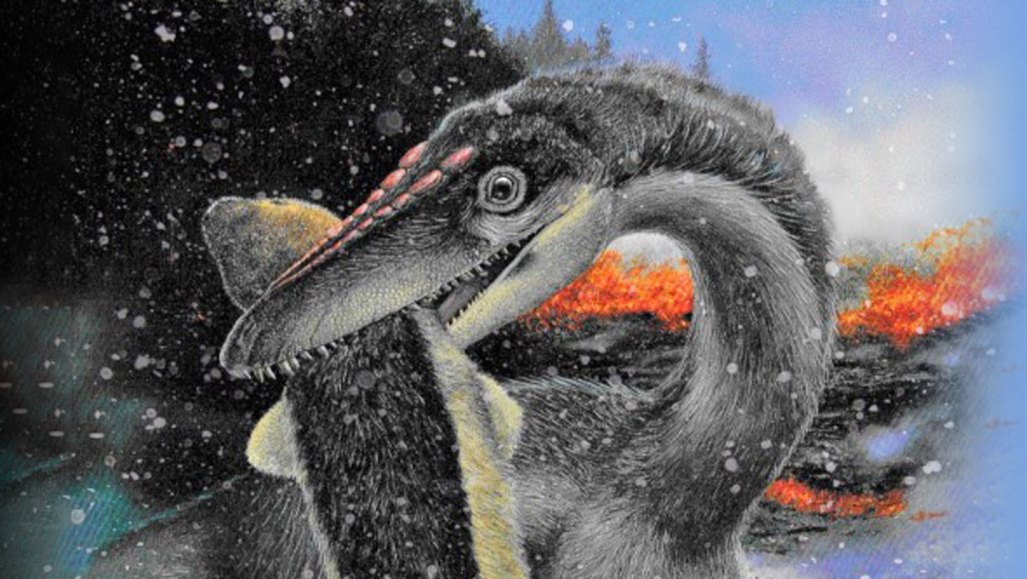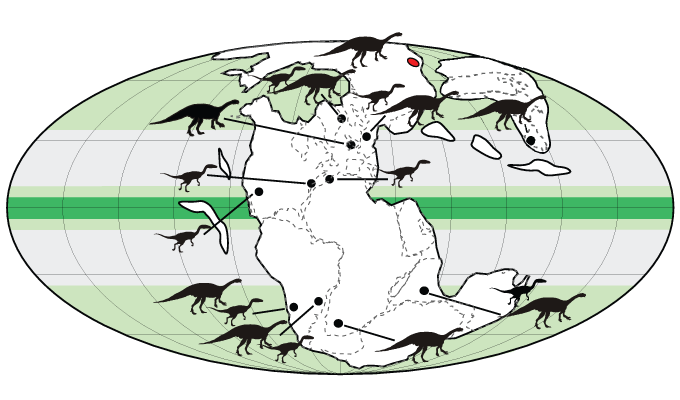Warm feathers may have helped dinos survive mass Triassic die-off
Fossil and geologic evidence show they weathered frigid volcanic winters in the Arctic

A feathered theropod dinosaur snags a mammal snack amid a snowy winter in this artist’s rendition. Massive volcanic eruptions likely triggered cold spells about 202 million years ago.
Painting by Larry Felder
Share this:
- Share via email (Opens in new window) Email
- Click to share on Facebook (Opens in new window) Facebook
- Click to share on X (Opens in new window) X
- Click to share on Pinterest (Opens in new window) Pinterest
- Click to share on Reddit (Opens in new window) Reddit
- Share to Google Classroom (Opens in new window) Google Classroom
- Click to print (Opens in new window) Print
Widespread volcanic eruptions likely blocked out the sun roughly 202 million years ago for long periods. The resulting chill triggered a mass extinction event. Three-fourths of the planet’s species died off. These included many large reptiles. Yet dinosaurs, somehow, survived and went on to thrive. Feathers may explain why, a new study finds.
Dinosaurs are often thought of as heat-loving. They were well suited to the steamy greenhouse environment of the Triassic Period. The secret to their survival? It may have been how well adapted they were to the cold. Unlike other reptiles of the time, dinosaurs had warm coats of feathers. These could have helped the creatures weather short but intense cold spells after volcanic eruptions, the new study proposes.
Along with carbon dioxide, volcanoes spew sulfur particles into the atmosphere. Those clouds can darken skies for years. As less sunlight reaches Earth’s surface, global temperatures drop. This can create what is sometimes called a “volcanic winter.”
“We’ve known for a while that there were probably volcanic winters” associated with the massive eruptions, says Paul Olsen. He’s a paleontologist at the Lamont-Doherty Earth Observatory at Columbia University in New York City. But it wasn’t clear what role they might have played in extinctions.
In fact, such winters occurred at the end of the Triassic, Olsen and his colleagues show in the new study. They also found evidence that dinosaurs were there to weather those winters. The team worked at a site called the Junggar Basin. It’s in what is now northwestern China. But at the end of the Triassic, it was in the High Arctic, near the top of the world. There, the team found rock fragments that could only have been deposited by ancient ice. Right alongside were the footprints of dinosaurs. The researchers described them July 1 in Science Advances.
“There is a stereotype that dinosaurs always lived in lush tropical jungles,” says Stephen Brusatte. He’s a paleontologist at the University of Edinburgh in Scotland. He was not involved in the new study but finds the evidence of cold weather convincing. In dinos’ early days, “the higher latitudes would have been freezing,” he says — “even covered in ice during parts of the year.”
Cold at the poles
The Triassic Period ended with a bang. Around 202 million years ago, the supercontinent Pangea began to break apart. Massive volcanic eruptions burst forth as the Earth’s crust split.
Levels of carbon dioxide, or CO2, were extremely high during the late Triassic and early Jurassic. Much of it likely traced back to those eruptions. Many scientists thought Earth was steamy and warm as a result of all that CO2. Plus, there’s no evidence of any polar ice sheets at that time. Instead, thick forests stretched all the way to the poles.
The Junggar Basin was one such forested region. Conifers and deciduous trees grew alongside a massive ancient lake. Dinosaurs certainly lived there. No one has yet found bones at the site, but the creatures did leave footprints. Many are preserved in the siltstones and sandstones that formed at the bottom of the lake.
The new study tells us more about the region. Despite extremely high CO2 levels, the winters could be harsh and frigid. The lake likely froze over, at least partially. Evidence for this comes from those rocks with the footprints. The scientists studied the sizes of particles, or grains, in the rocks. Many grains weren’t part of the original lake mud, the team found. They had been carried to the lake from elsewhere.
Most likely, Olsen says, these grains are “ice-rafted debris.” That term refers to bits of rock that freeze to the base of ice along a shoreline. They hitch a ride with the ice when it drifts into open water. As the floating ice melts, the bits of rock sink, deposited in new territory.
Finding such grains in the same rock as the footprints means the dinosaurs and ice were there at the same time.

Winter is coming
Volcanic winters might have been long. Depending on how long volcanoes kept erupting, they could have lasted tens or even hundreds of years, Olsen says. The Triassic eruptions left behind a huge sheet of lava. (It now spans 7 million square kilometers — about 2.7 million square miles — across Africa, Europe and North and South America.) That suggests the eruption pulses could have spanned at least tens of thousands of years — maybe even a million. That, in turn, could have meant prolonged winters. Freezing bouts may have reached all the way to the tropics, the team says. Reptiles that couldn’t handle the cold may have died off.
Fossil evidence shows many types of dinosaurs had feathers. They show up in everything from meat-eating theropods to plant-dining ornithischians (Or-nih-THISH-ee-uns). Even flying reptiles called pterosaurs had them, recent reports show. That suggests that the insulating fuzz has been around for even longer than once thought. Feathers may have appeared up to 250 million years ago. That would have been in a common ancestor of dinosaurs and pterosaurs.
Feathers may have helped dinosaurs stay warm. And that may have been enough to survive long, late-Triassic winters, Olsen and colleagues say. Those dino survivors might then have been able to spread rapidly during the warming Jurassic. They might have moved into areas left vacant by less hardy reptiles.
Randall Irmis is a paleontologist at the University of Utah in Salt Lake City. He did not take part in this analysis. It makes sense that a warm coat of feathers could have helped northern dinosaurs survive, he says. But did the tropics get cold enough to give feathered dinos an advantage there? That isn’t yet clear, he says.
Feathers are probably just one of many reasons why dinosaurs diversified and spread rapidly across the globe at the start of the Jurassic, Irmis says. “There’s a lot that plays into why they became such a successful group.”







